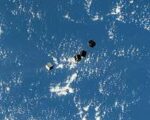The United States Coast Guard’s newest polar security cutter, USCGC Storis (WMSP-919), has successfully completed its first operational patrol in the Arctic. The mission included surveillance of Chinese naval vessels operating near the U.S. Exclusive Economic Zone (EEZ) off Alaska. This milestone marks a significant step in bolstering American presence and maritime domain awareness in the increasingly contested polar region.
Storis Returns to Service as a Modern Polar Security Cutter
The original USCGC Storis served from 1942 to 2007 and was renowned for its service during World War II and Cold War-era Arctic missions. The new vessel bearing the same name is part of the U.S. Coast Guard’s Polar Security Cutter (PSC) program aimed at revitalizing American icebreaking capabilities.
Commissioned in early 2025 and homeported in Kodiak, Alaska, the new Storis is a medium icebreaker designed to operate year-round in polar conditions. It is equipped with advanced navigation systems, aviation facilities for MH-60 Jayhawk helicopters and UAVs, and enhanced C4ISR capabilities for joint operations with U.S. Navy and allied forces.
While not as large or heavily ice-capable as the forthcoming heavy PSCs being built by Halter Marine (now Bollinger Mississippi Shipbuilding), the Storis fills a crucial gap between aging legacy cutters like USCGC Healy (WAGB-20) and future assets still under construction.
Tracking PLAN Vessels Near Alaska
During its inaugural patrol in August–September 2025, USCGC Storis detected a formation of five People’s Liberation Army Navy (PLAN) vessels operating within international waters but close to Alaska’s EEZ boundary. The group reportedly included a Type 052D destroyer, a Type 054A frigate, an intelligence-gathering ship (likely Type 815A), and two auxiliary support ships.
This is not the first time PLAN ships have approached U.S. waters near Alaska—their presence has been noted periodically since at least 2015—but their frequency and complexity have increased notably since 2021. In this instance, the PLAN flotilla was shadowed by both USCG assets and U.S. Navy P-8A Poseidon aircraft conducting maritime patrols out of Elmendorf AFB.
A senior Coast Guard official stated that “Storis maintained visual contact with foreign vessels while asserting freedom of navigation rights.” No violations of U.S. territorial waters were reported during this deployment.
Enhancing Maritime Domain Awareness in the High North
The Arctic is rapidly emerging as a theater of strategic competition due to climate change-driven accessibility and resource potential. Melting sea ice has opened new shipping lanes such as the Northern Sea Route along Russia’s coast and increased interest from non-Arctic nations like China under its self-declared “near-Arctic state” policy.
The deployment of modernized cutters like Storis supports broader Department of Homeland Security objectives for enhanced maritime domain awareness (MDA). Equipped with surface search radar optimized for ice-covered environments and satellite-linked EO/IR surveillance systems, Storis contributes real-time data to NORAD-USNORTHCOM fusion centers tracking vessel movements across the Bering Strait choke point.
This capability is especially critical given limited satellite coverage at high latitudes and persistent GNSS degradation caused by space weather phenomena common near magnetic poles—factors that complicate ISR operations above 70°N latitude.
Joint Operations & Interagency Coordination
Storis’ patrol also served as a testbed for interoperability between Coast Guard District Seventeen assets based in Alaska—including cutters Alex Haley (WMEC-39) and Kimball (WMSL-756)—and other stakeholders such as NOAA research vessels conducting hydrographic surveys nearby.
The cutter hosted embarked personnel from DHS Office of Intelligence & Analysis as well as liaison officers from Canadian Joint Task Force North under NORAD cooperation protocols. The integration highlights growing emphasis on whole-of-government approaches to Arctic security encompassing defense readiness, environmental stewardship, search-and-rescue coordination under SAR agreements with Canada/Russia/Norway/Denmark/Iceland/Finland/Sweden/U.S., and indigenous community engagement across coastal Alaska regions.
Implications for Future Force Posture
The successful deployment of USCGC Storis underscores both progress made under recapitalization efforts for America’s polar fleet—and persistent gaps remaining until full PSC program maturity expected post-2030. Currently only one operational heavy icebreaker—the aging Polar Star—remains available year-round; Healy provides medium-duty science missions but lacks tactical ISR capacity or defensive armament found on newer platforms like Storis or planned PSCs.
- PSC Program: Three heavy polar security cutters are planned; first delivery now expected ~2028 after multiple delays related to design finalization and COVID-era supply chain disruptions.
- Navy Integration: Increasing emphasis on joint operations with PACFLT assets including Virginia-class submarines transiting Arctic routes during ICEX exercises; future plans may include forward-deployed unmanned surface vehicles (USVs) or seabed sensors integrated via C4ISR nodes on cutters like Storis.
- NATO Coordination: While NATO does not have formal jurisdiction over Arctic governance structures (which fall under UNCLOS frameworks), member states are increasingly coordinating via bilateral/multilateral exercises such as Operation Nanook-Tatigiit hosted annually by Canada—and now involving U.K., France, Norway alongside U.S./Canada CG-Navy units.
A Strategic Asset for an Evolving Theater
The reactivation of the historic name “Storis” signals more than just nostalgia—it represents renewed commitment to sustained presence in one of Earth’s most strategically vital frontiers. As great power competition extends into previously inaccessible domains like high-latitude sea lanes rich in hydrocarbons/fisheries/data cables/mineral rights—and vulnerable to hybrid threats ranging from illegal fishing to cyber interference—the role of multi-mission platforms like USCGC Storis will only grow more central to defense planners’ calculus across INDOPACOM/NORTHCOM theaters alike.









